Yudofu is a hot pot dish that have originated around Nanzenji Temple in Kyoto Prefecture. Its roots are said to be Buddhist cuisine, and there are many famous yudofu restaurants in Kyoto outside of the Nanzenji area. When it comes to Kyoto’s famous food, many tourists probably think of yudofu. However, have you ever wondered what ingredients and sauce used in Yudofu and what are the differences with other types of nabe? We will explain about its features below.
What is Yudoufu?
Yudoufu is a tofu-based hot pot dish that is popular in Kyoto, Japan. Locals heated the cubed tofu and water in a pot lined with kombu seaweed before serving it with soy sauce and condiments. Distinguished by its soft texture and the ability to enjoy the taste of the ingredients themselves. Japanese commonly uses tofu, water, kombu seaweed, and a dipping sauce. They frequently eat this with kombu seaweed in a pan, they just add tofu and water, heated it, and then removed it when warm. Soy sauce, a combination of soy sauce, sake, mirin, dashi stock, etc., or ponzu soy sauce is used as the dipping sauce. Furthermore, locals occasionally use egg yolk, leek, tomato, and other unique varieties.
Yudoufu History

Tofu was introduced to Japan in the Nara period. From the 7th century to the 8th century, when Buddhism was introduced to Japan, exchanges with the continent became more and more popular, and that they also introduced tofu around that time. There seems to be no official record of when yudoufu was born, but it originated in Buddhist cuisine around Nanzenji Temple in Kyoto.
The monks of the temple followed the Buddhist precepts that killing is not good, and lived without eating animal meat. Therefore, most of the protein that humans need is from soybean dishes, and tofu was especially indispensable. Japanese eat yudoufu today by boiling tofu in kombu dashi, but the original yudoufu was made by boiling yakidofu, which is said to have been a dish similar to oden. In addition, this boiled tofu is still served at Nanzen-in Temple. As mentioned earlier, yudoufu was born in Kyoto, and tofu dishes developed from the latter half of the Muromachi period onwards.
Yudoufu Recipe
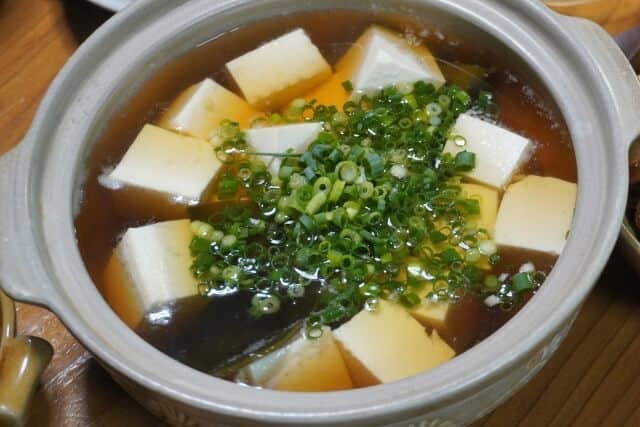
Yudoufu Ingredients
| Ingredients of Yudoufu for 2-3 person | Measurements |
|---|---|
| Tofu | 60g |
| Water | 1000g |
| Kombu | 3g |
| Grated daikon radish and grated ginger | 5g each |
| Chopped green onions | 8g |
| Shredded shiso leaves | 4g |
| Soy sauce | 100g |
| Mirin | 14g |
| Sake | 14g |
| Dried bonito shavings | 20g |
How to make Yudoufu
Prepare an earthenware pot large enough to hold the tofu, and add kelp to the water. Then, make the seasonings with soy sauce, mirin, sake, and bonito flakes. Once the Tosa soy sauce is ready, add 1 part of water to 2 to 3 parts of the Tosa soy sauce to dilute it a little.
In addition to your favorite tofu such as cotton or silken tofu, condiments are essential for yudofu. Among the condiments, prepare the grated radish and grated ginger. If you can prepare other ingredients, you can prepare chopped green onions or shredded shiso leaves.
Cut one piece of tofu into 6 to 8 pieces and gently put them in the pan. lace pan over medium heat and add 1-2 pinches of salt for a touch of flavor.
Take the warm tofu in a bowl, add grated daikon radish, grated ginger and other condiments, and pour the soy sauce made by mixing Tosa soy sauce with water.
Common ingredients of Yudoufu

The ingredients for yudoufu are very simple: tofu, water, and kombu seaweed. Therefore, the quality of the ingredients greatly affects the taste of the dish rather than the cooking method. By the way, the ingredients of tofu are 80-90% water. The quality of the water, in particular, greatly affects the quality of yudoufu.
Vegetable
Recommended vegetables that go well with yudoufu include Chinese cabbage, mizuna, garland chrysanthemum, bean sprouts, radish, and green onions. By adding vegetables, the volume increases, and the texture increases. If you use vegetables with colours such as green, red, and yellow, the white tofu will stand out and look better.
Mushroom
Recommended mushrooms that go well with yudofu include shiitake, shimeji, and enoki. Adding mushrooms enhances the flavour of the whole dish. You can also enjoy the difference in texture between tofu and mushrooms, and the yudofu will have a deeper flavor.
Meat
The recommended types of meat that go well with yudofu are chicken and pork. Chicken thighs are good, and pork ribs and thinly sliced meat are good. Japanese also recommend chicken dumplings made with minced chicken.
Adding meat to the simple flavor of yudofu adds umami and richness, making it even more satisfying to eat. The taste changes depending on the type of meat, so you can enjoy various arrangements without getting bored.
Fish
Types of fish that go well with yudofu include cod, gurnard, filefish, and monkfish. Seafood goes well with kombu dashi and is one of the recommended ingredients to add to yudofu. It goes well with white fish, which has a relatively proteinaceous taste and brings out the flavor of the soup stock and tofu even more without overpowering it.
Yudoufu sauce and condiments
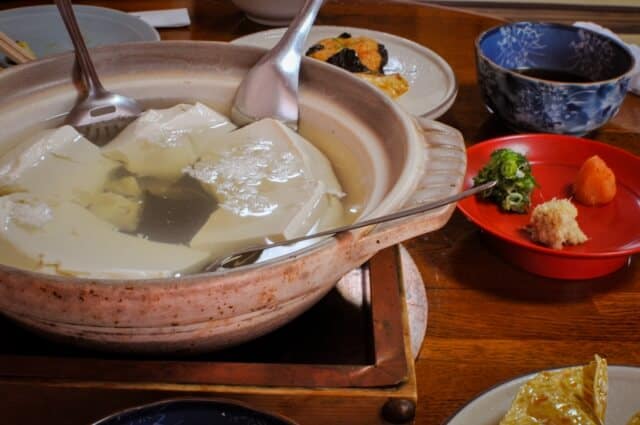
Yudofu is popular by its simple taste, and it is also attractive that the flavor changes depending on the sauce and condiments you add.
Sauce
The sauce that goes well with yudofu is ponzu soy sauce, mentsuyu, sesame sauce, etc. You can enjoy different flavors depending on your preference, such as when you want to enjoy a refreshing taste or when you want to enjoy a rich flavor.
Seasoning
Condiments that go well with yudofu include bonito flakes, grated ginger, grated garlic, yuzu pepper, chopped green onions, grated radish, and grated maple leaves. By adding spices with a strong aroma and flavor, you can enjoy yudofu without getting tired of it. The taste also changes depending on the combination of the sauce.
Health benefits of Yudoufu
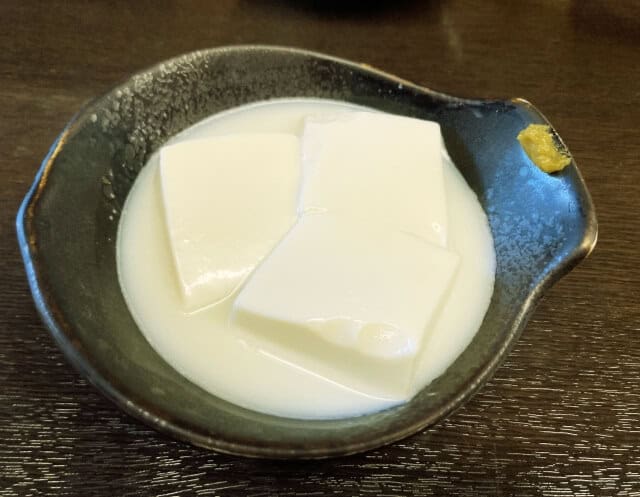
Activate fat metabolism
The lecithin contained in tofu has a strong effect on lipid metabolism, reducing bad cholesterol and increasing good cholesterol.
Prevent rebound
If you are on a diet with extreme dietary restrictions and a lack of energy, your body will decide that it is dangerous and will use your muscles as an energy source. The rich protein contained in tofu quickly decomposed and absorbed and efficiently builds muscle.
Raise your metabolism
Soybean saponin contained in tofu has a strong antioxidant effect and expected to have the effect of removing lipids stuck to blood vessels and promoting metabolism while suppressing lipid oxidation.
Where to buy Yudoufu
Okutan Shimizuten (総本家ゆどうふ 奥丹 清水店)
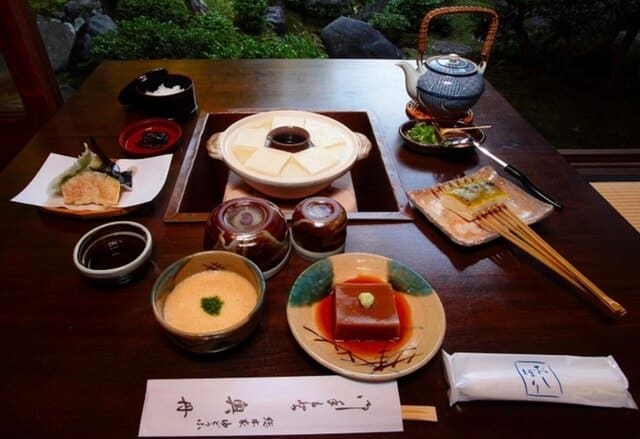
Founded in 1935, “Okutan Shimizuten” has inherited its history without changing the taste or atmosphere. You can enjoy your meal while gazing at the 600 tsubo-wide garden where you can enjoy the beautiful scenery of the four seasons. There is a homemade tofu workshop in the basement of this large garden, and the hands of craftsmen make the tofu used in the dishes of the day.
Gion Uemori

“Gion Uemori” is a kaiseki restaurant where you can enjoy beautiful Kyoto-style cuisine that makes use of Kyoto ingredients. Among them, we recommend “Yudofu and Yuba Kaiseki”. The tofu is from Sagano’s famous restaurant “Morika”, and the tofu, yuba, sashimi, and even tempura is a luxury. Yudofu can be added to the kaiseki cuisine, so it’s great for those who want to eat both.
Junsei Okabeya (清水順正おかべ家)

Okabeya is a Kyomachiya restaurant near the approach to Kiyomizu-Dera where you can casually enjoy homemade tofu. In the “Fuji” course, you can enjoy yudofu, simmered tofu, sesame tofu, tofu dengaku, vegetable tempura, rice, and pickles. They warmed the yudofu at a temperature that brings out the flavor of the tofu.
Takeaway
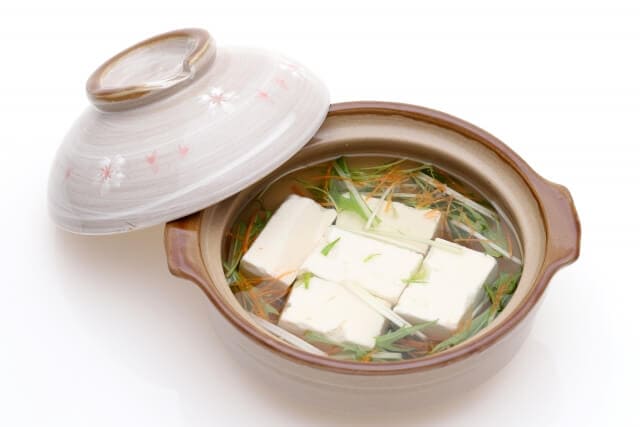
Many tourists probably think of yudoufu when they think of Kyoto‘s famous food (boiled tofu). Yudofu can be freely arranged due to its simplicity. It is also recommended to include meat and fish in addition to vegetables and mushrooms. Yudoufu goes well with any type of ingredient and can be made in a variety of ways, so experiment with your favourite ingredients and enjoy.
There are some other types of tofu dishes in Japan that you should try, such as Hiyayakko and Goma Tofu.

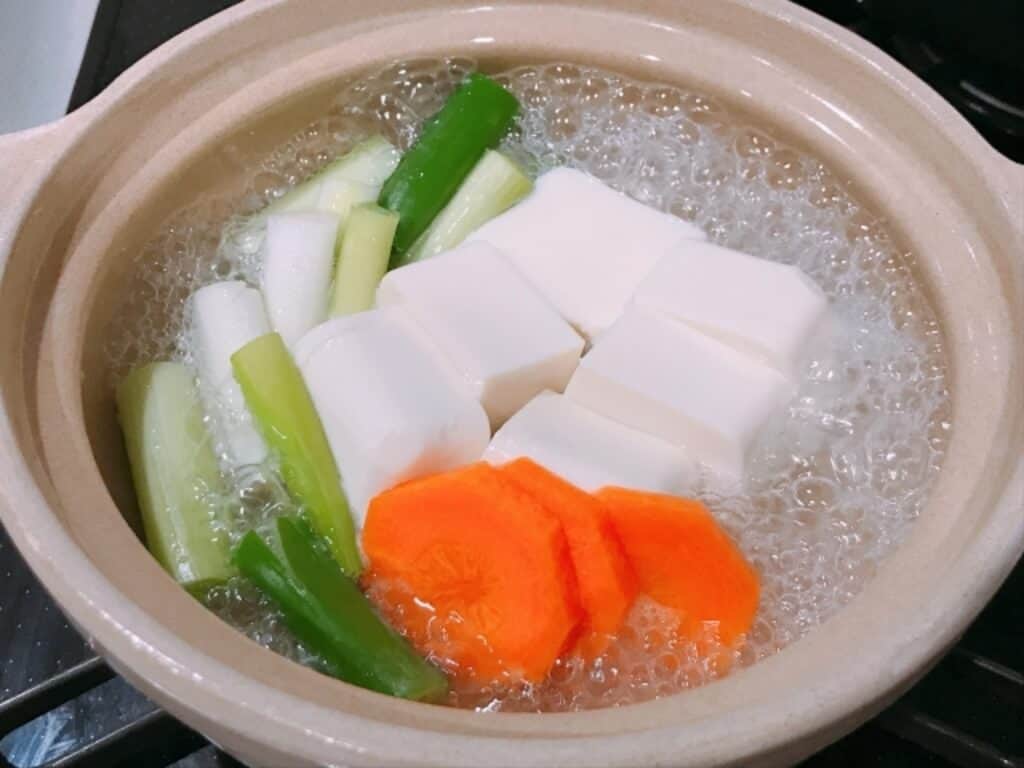
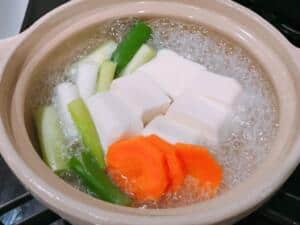
Comments